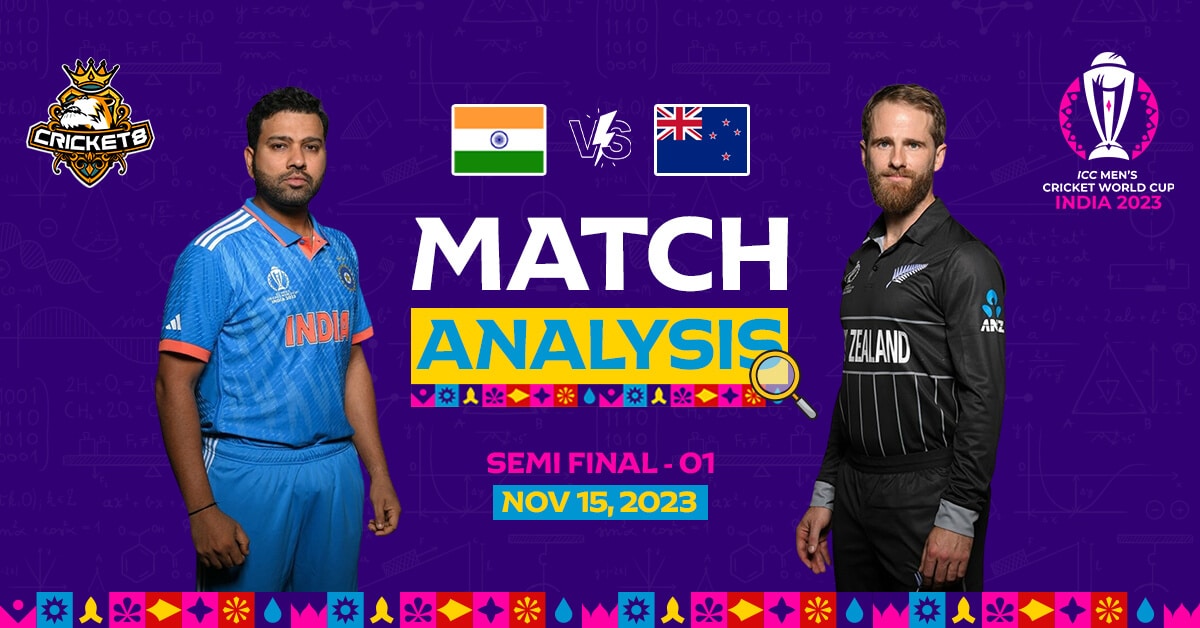Even the most dramatic writers of Bollywood can not imagine a script with so many iconic moments. Virat Kohli getting to the pinnacle of ODI centuries in front of the legend himself. Mohammed Shami enjoying the form of his life to deliver the knockout blow. Ravindra Jadeja completed a catch in a melodramatic fashion in front of a crowd holding their collective breath. In the end, it was a straightforward victory for the hosts who reached the fourth ODI World Cup final in their history. Virat Kohli looks destined to win the World Cup, and so do his teammates.
Team Lineups
Both teams played with an unchanged eleven from their respective last games. Team India, fresh from a thumping of Netherlands decided to field a full-strength team against the Dutch. The absence of Hardik Pandya in the team upsets the balance of the team to some extent, but India has enough firepower in their arsenal to replace him. Talented players like Prasidh Krishna, Shardul Thakur, Ishan Kishan and veteran Ravichandran Ashwin remained on the bench for the men in blue.
New Zealand unfortunately lost their most in-form bowler Matt Henry to a torn hamstring in the game against South Africa. Kyle Jamieson was called in as a replacement for the right arm pacer. Jamieson took his place on the bench alongside Will Young, Ish Sodhi and Jimmy Neesham. Kane Willamson has shown glimpses of his old self after recovering from a thumb injury. Mitchell Santner has adapted with the Indian pitches to bowl some wonderful pitches and Rachin Ravindra has displayed his immense talent with the bat back in the country of his ancestors.

India
- Rohit Sharma (Cap.) 2. Shubman Gill 3. Virat Kohli 4. Shreyas Iyer 5. KL Rahul 6. Suryakumar Yadav 7. Ravindra Jadeja 8. Mohammed Shami 9. Jasprit Bumrah 10. Kuldeep Yadav 11. Mohammed Siraj
New Zealand
- Devon Conway 2. Rachin Ravindra 3. Kane Willamson (Cap.) 4. Daryl Mitchell 5. Mark Chapman 6. Glenn Phillps 7. Tom Latham (WK) 8. Mitchell Santner 9. Lockie Ferguson 10. Tim Southee 11. Trent Boult.
Indian skipper Rohit Sharma won the toss and elected to bat first without any hesitation. The track at Wankhede is a balanced track that is most likely to stay the same throughout the game. The average first innings in the last ten games at this ground is 318. The latest game at this stadium saw Glenn Maxwell taking the game away from the Afghans with his daredevil batting. The Kiwis can find the heat of Mumbai presenting a different type of challenge altogether.
The decision to bat first should be a no-brainer at Wankhede. But the possibility of dew under the lights could cause some issues for the spinners in the second innings. At this World Cup, the aggregate first innings score during the powerplay is 209, much more than the aggregate in the second innings (168). The teams batting first have lost 5 wickets, whereas the teams chasing have lost a total of 17 wickets. It can be a different ball game under lights at Wankhede with the new ball moving in different directions.
Fixture
India and New Zealand have faced a total of 117 times in the ODI format. India has won 59 of those matches, New Zealand came out triumphant on 50 occasions. 7 of those games have failed to yield any result with one game ending in a tie. On Indian soil, the statistics are pretty one-sided with India outnumbering Kiwi victories to 30-8.
At the World Cups, the teams have clashed on 10 occasions. New Zealand is slightly ahead with 5 victories to India’s 4. These teams also played in the last edition’s semi-final, New Zealand won the two-day thrilling contest by 18 runs. Two years later, New Zealand defeated Team India in the World Test Championship final. The sides met last month in Dharamshala with India coming out with a win by 4 wickets. The two teams last met in a bilateral series back in January of this year with India edging the series 2–1 in their favour.
India had an impeccable record of nine straight victories out of nine games coming into this game. New Zealand started impressively by winning each of their first four matches, then lost their way by losing the next four. The Black Caps0——————————————————————————————————————————————————————————– needed a victory against England in the last game to hold on to the fourth and final semi-final spot.
| Venue | The 46th match and first semi-final clash between the host India and the previous edition’s runner-up New Zealand was held at the iconic Wankhede Stadium in Mumbai, Maharashtra. |
| Date | The game started at 02:00 p.m. on Wednesday, November 15. |
Captaincy & Tactics
Despite winning the toss, India’s captain Rohit Sharma must have had the lingering doubts of dew under lights later on. India is a side that has world-class spinners in the team, but a wet outfield could present a tricky conundrum in front of the slow bowlers. However, the pace trio of Bumrah, Shami and Siraj is capable of moving even on the flattest of the tracks. The formidable batting lineup can dismantle the opponent bowlers in any condition around the world.
Rohit Sharma is one of the two batters who averages over 60 and maintains a strike rate of over 100 in ODI World Cups. The local boy started off the proceedings by whacking the ball all along the ground. The Kiwi pacers made the grave mistake of bowling short to Sharma and they were duly punished through a flurry of pull shots by the Indian great. Rohit Sharma has scored a total of 550 in this tournament, 226 of which came in the first 20-balls. Sharma had scored at a rapid rate of 120+ in five innings when he made 40+ during the powerplay. The power-hitting of Sharma has been a principal factor in India getting off to a flyer.

Kohli and Iyer started cautiously, but they eventually changed gears to rip through the New Zealand attack. The duo put on 255 runs in 38 overs by tormenting the New Zealand bowlers. KL Rahul came late but made sure to put his mark on the game by scoring 39 from 20 balls, hitting 7 boundaries in the process. The Indians unleashed their batting fury upon the Kiwis in the last ten overs, they added 110 runs to the board in that stage.
Mohammed Shami used his angles well to move the ball into the right-hander. Daryl Mitchell and Kane Williamson made the Kiwi ship stable but the required run rate kept climbing higher and higher. Daryl Mitchell was magnificent with the bat as he kept hitting the ball on the leg side. He also showed versatility with sweep shots piercing the offside field.
Williamson was also finding the middle of the bat. But once Williamson and Latham got out in the same Shami over, the target seemed to move further away from the grasp of the away team. Glenn Phillips struggled early but settled well to smash the ball for a couple of sixes. But no one came close to supporting Daryl Mitchell in pursuit of the huge target. Neither Mark Chapman nor Tom Latham managed to contribute with the bat.
Rohit Sharma’s decision to bring Kuldeep Yadav to the attack turned into a masterstroke as the left-arm chinaman bowler gave only 2 runs in the 41st over of the innings. Bumrah came to bowl the next over, he conceded seven runs and picked up the important wicket of Glenn Phillps. The 43rd over was bowled by Kuldeep – this time it yielded just four runs. In the end, the adaptability of the Indian bowling lineup was too good for the Kiwis.
Batting Analysis
The opening pair of Shubman Gill and Rohit Sharma now has the highest number of 50+ scores in a calendar year (14) for the first wicket. It was 24/4 after 10 overs in Manchester. Rohit Sharma now has the highest sixes in ODI cricket history (51), surpassing Chris Gayle (49). Sharma also has the highest number of sixes in one edition (28).
Kohli’s century came on the 42nd over of innings when the right-hander flicked Lockie Ferguson behind the square to get the two required for his record hundred. It took Sachin 451 innings to reach 49 hundred, whereas Kohli needed just 277 innings to surpass the little master’s record. Kohli also has the highest number of 50+ scores in a single version of the ODI World Cup.
He also broke the record for the highest number of runs in a single World Cup edition set by Tendulkar (673 runs in 2003), Kohli has 711 runs at this World Cup at an astounding average of 101.57, striking the ball at a rate of 90.67 per hundred balls. It took Kohli to score his fifty off 59 balls. After reaching the half-century mark, Kohli quickly changed gears to score the next 50 runs off 53 balls. The whole of Wankhede stood up to applaud one of the iconic moments in the accomplished career of a champion cricketer.

It just took 67 balls for Shreyas Iyer to reach his century, this is the fastest century in a knockout game. The 397 posted by India is also the highest total in the World Cup knockout phase. The young batter is showing how a capable no. 4 can contribute to the team, a position that went wrong for the Indians in 2019. Iyer now has scored 526 runs at this World Cup at a whooping average of 75.14 and a staggering strike rate of 113.11.
New Zealand needed early impetus to chase the massive target down but they failed to get any momentum from the beginning with Shami getting both the openers. Rachin Ravindra struggled to get a bat on the ball and got out in the process. Devon Conway hit three boundaries before getting dismissed by the brilliant Shami. The straight seam deliveries while using the crease intelligently to deliver the ball from different angles caused a lot of problems for the Kiwi top order. They managed just 46 runs with the loss of two during the mandatory powerplay overs, this slow pace during the initial stage ultimately cost the game for them.
Mitchell was using the reverse sweep with dexterity against the Indian spinners who were not reluctant to give the ball some air. Kane Williamson’s lack of power hitting was exposed in the face of a big target, his innings of under 100 strike rate aggravated an already complicated situation for the 2019 finalists. Williamson eventually succumbed to the pressure of a steep run rate when he tried to heave Mohammed Shami down the leg side.
Bowling Analysis
It was a struggle for the New Zealand bowlers with Trent Boult going around the wicket on just the third over of the innings. Tim Southee failed to produce any movement off the pitch and was deposited over the boundary line at regular intervals. Mitchell Santner was the only bowler who managed to find some momentum going with 51 runs conceded in 10 overs. The other two spinners gave away 93 runs in their combined 12 overs. Tim Southee conceded exactly 100 runs from his 10, and Shreyas Iyer was in scintillating touch against the right-arm bowler.
Mohammed Shami was not selected for the first four games in this World Cup campaign. The 33-year-old pacer from Uttar Pradesh finally got his chance against New Zealand in Dharamshala, he started his record-breaking journey by claiming a fifer against the Kiwis.
Shami became the highest wicket-taker of this tournament with 23 wickets from only 6 games. Shami bowled 37 dot balls out of his 59 deliveries, keeping the run rate in check. His smooth action coupled with varying angles make him the deadliest white ball pacer in the world.
Kuldeep Yadav enjoyed an excellent shift in this match. The left-arm spinner bowled 26 dot deliveries, Daryl Mitchell finding his life difficult against Kuldeep. Mitchell scored 29 runs off this bowler with 13 of the balls failing to produce any runs. His 9th and 10 over was outstanding given the pressure he was under, just giving away 6 runs in these two overs. The sliders were lovely to see, the googlies surprised the batsmen and the skidders were difficult to deal with.
Jasprit Bumrah started the day off in an unfamiliar style, with 22 runs conceded from the first 3 overs. The five wide deliveries are a reminder that pressure can get to the very best of the athletes. Shami came as the first change and made the breakthrough with his first delivery of the game. Jadeja was introduced early to avoid the intrusion of dew. Both he and Kuldeep found some turn out of the wicket, but Mitchell was able to play them along the ground.

Bumrah was back to his best while bowling at the death. He deceived the batters with his wonderful change of pace and finding the blockhole regularly. Kuldeep has been bowling at a much quicker speed than before and changed the game with his tight bowling line. The six runs from his last 2 overs came at a crucial time when Rohit Sharma was desperately looking for solutions to the growing Kiwi problem.
The pressure kept mounting on the Indians until Mohammed Shami came back with a double blow. He has now got 54 wickets in just 17 World Cup games. Shami has got 42 wickets from 18 games this year so far, averaging just 15.73. The World Cup specialist has an incredible average of 12.90 with a strike in every 15 balls. Shami has got 194 wickets in 100 ODIs. If he manages to win the World Cup for his country, this might be the greatest individual bowling performance in World Cup history.
Fielding Analysis
Even the usual world-class level Indians could feel the pressure of a big game. KL Rahul who has not put a foot wrong in all World Cups missed a sitter to run Williamson out by breaking the stumps before gathering the ball in his gloves. Kane Willamson got another life when he was dropped at 52 by Mohammed Shami. Even Ravindra Jadeja failed to hit the stumps from a close range, the pressure was finally getting on the nerves of the Indians. There were also some occasions where the throws could have been better to put pressure on the batting side.
Ravindra Jadeja produced the desired result, however, when it mattered the most. He caught Glenn Phillps out on the boundary, a skier under the lights with the expectations of the most populated nation in the world resting on his shoulders. He repeated the feat six balls later, this time pouching Mark Chapman safely. Rohit Sharma missed a half chance but made amends later by taking the catch off Mitchell Santner. Shubman Gill made a lot of ground to stop a certain boundary hit by Glenn Phillps, saving three runs in the process. KL Rahul took a dazzling diving catch to his right to send Devon Conway on his way.
Earlier in the day, Kiwi skipper Kane Williamson pulled off a stunner to dismiss the dangerous Rohit Sharma. Willamson was backpedalling when he caught Sharma at mid-off. Glenn Phillps also produced a moment of brilliance by catching Suryakumar Yadav out at midwicket. Tom Latham missed a sharp chance to give the Indians an early reprieve.
Key Performances
Virat Kohli scored the record-breaking 50th ODI century in front of the legend Sachin Tendulkar himself to make sure India posted a mammoth total. Shreyas Iyer became the third Indian batsman after Rahul Dravid (1999) and Rohit Sharma (2019) to score back-to-back hundreds in the World Cups. His 105 from 70 balls propelled the Indian innings close to 400.
Shubman Gill was unlucky not to score a ton due to a cramp that forced him off the field. The youngster from Punjab accumulated 80 from 86 balls before this. Rohit Sharma started in a flamboyant style to post a quickfire 47 off 29 deliveries. KL Rahul put on a show of late fireworks of 39 from 20 balls. Tim Southee was the recipient of some heavy beating from the Indians. The veteran pace bowler claimed 3/4th of the Indian wickets but conceded 100 runs from his 10 overs. Trent Boult also could not make his mark with the ball, he got the scalp of Shreyas Iyer and gave away 86 runs from his 10 overs.

Daryl Mitchell played a magnificent innings of 134 from 119 balls. The 33-year-old all-rounder hit 9 fours and 7 sixes to take the game to the wire. The New Zealand skipper Kane Williamson played an innings of 69 from 73 balls, but the innings became irrelevant as the asking rate kept going up throughout the innings. His strike rate of 94.52 is an anomaly during a chase that started with almost 8 runs per over.
Glenn Phillps tried to revive the Kiwi chase with 41 runs scored from 33 balls. Mohammed Shami was once again the pick of the Indian bowlers with the figures of 7 for 57 runs. Kuldeep Yadav was parsimonious with the run rate and took the wicket of Mark Chapman. Despite the initial awkwardness, Jasprit Bumrah finished strong with 1 for 64 in his 10 overs. Kuldeep Yadav kept things tight with a tidy spell of 10 overs that yielded 1 wicket for 56 runs.
Turning Point
New Zealand needed 179 from 18 overs when Mohammed Shami came to bowl his 5th and 33rd over of the innings. The 188-run partnership between Daryl Mitchell and Kane Willamson kept the Kiwi hopes alive. Willamson was playing the role of an anchor with Daryl Mitchell operating as the chief destroyer. Kane Willamson flicked the second ball of the over straight to the deep cover fielder Suryakumar Yadav. Kane Willamson tried to hit the ball for a six but only managed to get the bottom edge.
Two balls later Mohammed Shami made it two in three balls. He pitched a ball on a good length that was coming back towards the batsman with the angle. Tom Latham played all around it and the ball struck the pads. The ball was bound to hit the middle and leg stump and Latham did not bother to review. This overchanged the whole complexion of the game. The ever-brilliant Mohammed Shami dealt a double blow that diminished the chances of the New Zealanders who were looking to qualify for back-to-back World Cup finals.
Match Result
India sealed their passage to the ODI World Cup final for the first time in 12 years with a revenge victory over the Kiwis by a big margin of 70 runs
Player of the Match
Mohammed Shami recorded the best bowling figures in a World Cup semi-final to top the chart of this tournament and win the Best Player of the Match award.
Brief Scorecard
| India Total: 397/4 (50 overs) | New Zealand Total: 327/10 (48.5 overs) |
| Virat Kohli 117 (113) | Daryl Mitchell 134 (119) |
| Shreyas Iyer 105 (70) | Kane Willamson 69 (73) |
| Tim Southee 3/100 (10 overs) | Mohammed Shami 7/57 (9.5 overs) |
| Trent Boult 1/86 (10 overs) | Kuldeep Yadav 1/56 (10 overs) |
Match Wrap-Up
It was another day dipped in blue in Mumbai as Team India finally got to a place where they belonged – the World Cup final. It was an outstanding batting performance from the men in blue followed by the individual brilliance of Mohammed Shami who is having a dream World Cup with the ball. India has made 10 wins out of 10 – a team imbued with a sense of camaraderie and integrity. They will take the field on Sunday in Narendra Modi Stadium to capture the ultimate prize that has been eluding them for the last 12 years. Will it finally be their year after a succession of decade-long heartbreaks?




